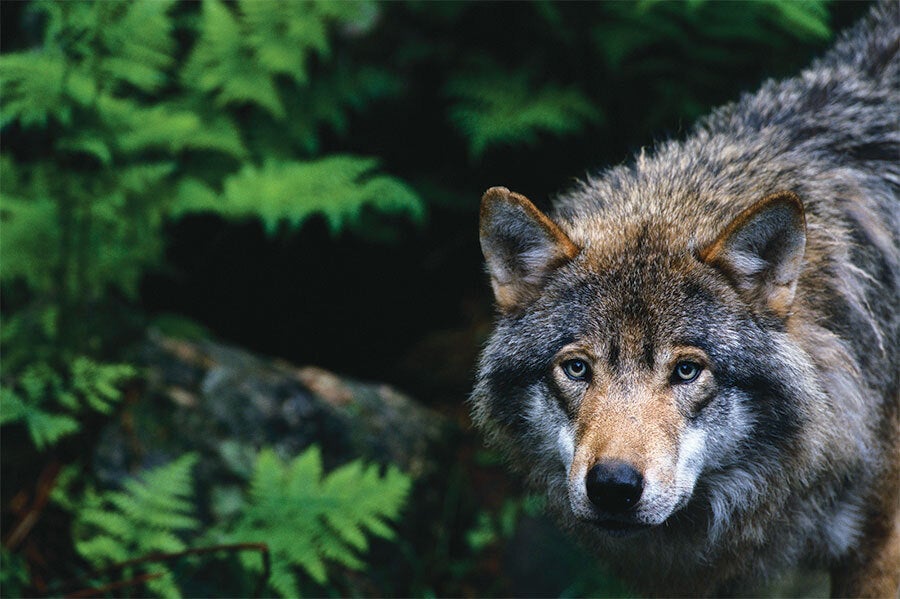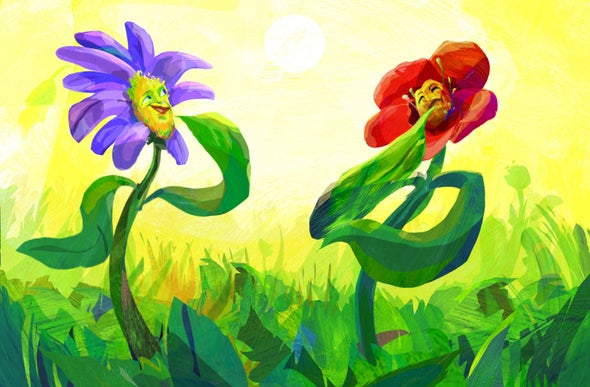Nonfiction
Smart Plants
A controversial invitation to reconsider green intelligence
Planta Sapiens: The New Science of Plant Intelligence
by Paco Calvo, with Natalie Lawrence
W. W. Norton, 2023 ($28.95)
Is the potted cactus on your windowsill a cognitive being? When the lettuce in your sandwich was cut from its roots, did it feel pain?
In a provocative new book, Planta Sapiens: The New Science of Plant Intelligence, philosopher Paco Calvo, with writer Natalie Lawrence, explores these questions, urging us not to fall into the “zoocentric trap” of believing that intelligence, agency and even consciousness are found only in animals.
Consider the movements of Mimosa plants, for example. A poke from a human finger usually causes the plants' leaves to shrink and fold against the stem. This response takes mere seconds—an excellent defense against herbivores. But after a few minutes in a bell jar suffused with anesthetic fumes, Mimosa becomes unresponsive. The same drugs quiet the gyrations of pea tendrils and the clenching of Venus flytraps.
Plants don't have nerve cells, but they do thrum with inner electrical signals that connect adjacent cells and transmit information along roots and stems. Networks of chemical messages complement these electrical connections. The effects of anesthetics on plant movement have been known since the 19th century, and recent research shows that they block electrical signals in plant cells, just as they do in animals. Unlike the hierarchical organization of nerves in animal brains, though, message signaling within plants is diffuse, ramifying through modular tissues and netlike vascular conduits. No longer can we think of plants as passive or inert; they are continually sensing and responding to their environments.
Such astonishing findings have led the book's author, among others, to controversially refer to the study of these processes as “plant neurobiology.” Calvo goes even further, suggesting that plants are cognitive beings and may have “diffused consciousness.” When a vine sends out tendrils, it does so with intent, he writes, using light and chemicals to explore and then home in on a target. The author claims the plant is not “simply reacting,” but it is “making meaning” through inner awareness, perhaps similarly to an octopus whose consciousness seems spread among its arms. Although electrical and chemical signaling inside plants are well established, assertions about plant cognition and possible consciousness are highly contentious. A rebuttal by some animal and plant scientists of Calvo and his colleagues' earlier work states that not only are such ideas wrong, but they harm scientific progress by misleading students and redirecting funding.
The problem is partly perceptual and linguistic. Our senses cannot grasp the rich communicative world of plants. We therefore lack language to describe the “intelligence” of a root tip in conversation with the microbial life of the soil or the “cognition” that emerges when chemical whispers ripple through a lacework of leaf cells. Calvo asks us to apply zoological and psychological concepts and terms to plants. In his view, the parallels between animal and plant biology are so strong that we should expand the boundaries of neurobiological and cognitive science to encompass plants. A better alternative might be to seek a lexicon that honors plants' sophistication without pigeonholing them with animal-derived ideas and words.
Vigorous debate about the nature of plants is surely a sign of a healthy field. Science, at its best, progresses through a reciprocal interplay between speculation and experimentation. Calvo's stimulating book draws us into that process, with an emphasis on the speculative. Could plants suffer, he wonders? When growing roots wriggle away from unexpectedly salty soil, might a psychological experience of distress or surprise direct their physiological response? The experimental evidence for these conjectures is currently scant, so the book repeatedly calls for further investigation.
These arguments would be more powerful if plants themselves were more clearly and frequently foregrounded. When they do appear—young bean plants lunging at poles, hollyhocks anticipating where the sun will rise—the book shines. But this green glow is often muted. In a chapter on ecological cognition, for example, instead of writing about plant communities, Calvo mostly offers analogies with animal behavior and human culture. This is a regrettable omission because if plant cognition does exist, it surely is at its height in biodiverse forests, deep-rooted prairies or thoughtfully tended agricultural landscapes.
Plant life is, above all, decentralized and engaged in reciprocal relationships with other species. And our species has homogenized and destroyed many of these formerly effervescent plant communities, throwing them into crisis. With this erasure, we lose the intelligence—however we choose to speak of it—brought to us by hundreds of millions of years of evolution.
Our human abilities are thus challenged by the rest of the living world: Look at what your cognition has wrought. Will you sapient apes change your ways? Instead of being misleading, as critics have claimed, Planta Sapiens helps us do so by expanding our imaginations and provoking more creative science. We may not learn whether lettuce has feelings, but we do come away with deeper empathy and admiration for plants. —David George Haskell
David George Haskell is a biologist and award-winning author. His most recent book is Sounds Wild and Broken (Viking, 2022).
Nonfiction
Big Bad Wolves
Tracking an archetype of fear

Wolfish: Wolf, Self, and the Stories We Tell about Fear
by Erica Berry
Flatiron Books, 2023 ($29.99)
In 2011 a wolf known as OR-7 trotted toward the forests of western Oregon, his radio collar broadcasting what would become a years-long, 3,000-mile journey to find a mate and a new home. As he moved into areas that had not seen a wolf in more than 70 years because of government-incentivized extermination campaigns, OR-7 quickly achieved celebrity status, captivating the public and inspiring, according to one headline, “hope and dread.” To understand why these canines channel our most visceral emotions, author Erica Berry examines in Wolfish what a wolf “brings up beyond itself.”
Berry's path of inquiry is a deeply personal one. Struggling with anxiety, she tries to pinpoint its origins in her life and finds in the wolf a new way to explore her relationship with her own fears. Humans have long imbued wolves with coded meaning, and although the specifics of the archetype shift with culture and context, wolves function as “a pressure point in our psyches.” Berry explores this role through wide-ranging research, juxtaposing the “wolves” in her life—her fears around personal safety, solo travel and loss of family—with biological wolves and the cultural touchstones they represent.
This unorthodox approach allows for the complexity of both Berry's personal journey and the wolf's status as a rich cultural avatar. In the chapter “Girl v. Wolf,” Berry unspools the parallels between her experience attending a college far away from her family and the wolf's quintessential role as a lurking threat to girls who leave home. She describes encounters with Big Bad Wolves that made her feel frightened and uncomfortable, but she also explodes the simplistic lessons of the fairy tale by examining how the story's evolution has distorted its original emphasis on survival rather than victimhood. She reflects poignantly on her connections with other female victims of violence whose fates, like Little Red's, were co-opted to serve others' agendas and to assuage—or exacerbate—their fears.
The book's narrative focus frequently pivots, creating a sense of uncertainty and intrigue not unlike what one would feel while journeying through an unfamiliar wood. Although these paths are occasionally disorienting, Berry is a skillful guide, highlighting the wolf's influence on everything from creation myths to viral memes and from government policies to proverbs. —Dana Dunham
In Brief
Feed Them Silence
by Lee Mandelo
Tordotcom, 2023 ($19.99)
Horror, fantasy and science fiction—and even nonfiction, like Erica Berry's Wolfish, also out now—have long explored the union of human and wolf, finding surprising correspondence between the civilized and primal. Lee Mandelo's crisp, urgent novella, centered on a study that links the consciousness of a researcher to that of one of North America's last wild wolves, is a new leader of the pack. While Dr. Sean Kell-Luddon's experience of the wolf's perceptions rouses animal hungers that threaten her human relationships, the horror here comes from the fullness with which she understands the cold, hunger and loss animals endure as they fight to survive. —Alan Schersturhl
Your Brain on Art: How the Arts Transform Us
by Susan Magsamen and Ivy Ross
Random House, 2023 ($28)
Susan Magsamen and Ivy Ross walk a fine line between expounding the health benefits of participating in art and arguing that such therapeutic effects need not be perfectly understood by science to be useful. Citing enough research to assuage skeptics, Your Brain on Art provides abundant ideas for engaging with the arts, ranging from the intuitive (memorizing dance choreography to stave off dementia) to the outlandish (sounding a tuning fork during a business meeting to reduce stress). No single method is for everyone, the authors maintain, but they throw enough spaghetti at the wall to inspire experimentation with new creative practices. —Maddie Bender
A Brief History of Living Forever: A Novel
by Jaroslav Kalfař
Little, Brown, 2023 ($28)
In 2030 biotech researcher Tereza embarks on an expedition across the Czech Republic and the authoritarian U.S. to recover the remains of her long-estranged mother, Adéla, after their reunion is cut short by Adéla's sudden death. Told from the mother's perspective from beyond the grave, the novel traces the way nativism spreads and how morally dubious technologies such as surveillance and immortality science thrive under a fascist, one-party-rule government. Author Jaroslav Kalfař turns an ambitious premise (a person whose body has expired but whose consciousness lives on) into a moving, frightening story about the strength of family bonds. —Michael Welch
.jpg)

